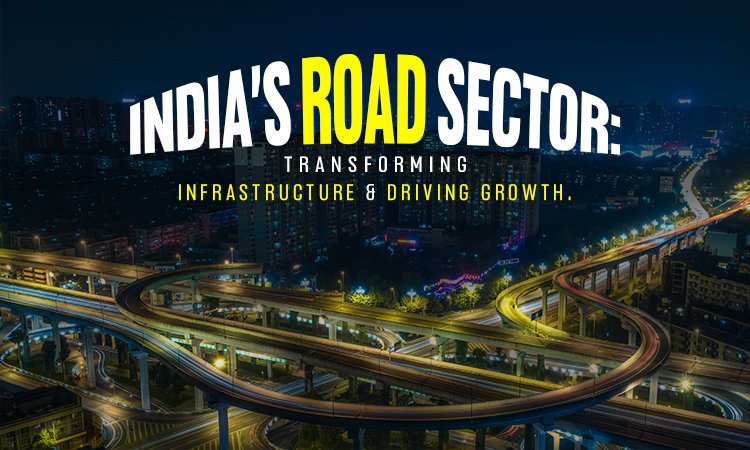India’s Road Sector: Transforming Infrastructure and Driving Growth

The road sector in India is experiencing an unprecedented phase of growth, with strong government support acting as the key catalyst behind its continued success. Over the past decade, the Ministry of Road Transport and Highways (MoRTH) has invested a staggering Rs 10 trillion in the construction and maintenance of national highways. This robust investment underscores the government’s commitment to developing world-class road infrastructure that will fuel economic growth and enhance connectivity across the country.
National Highways Expansion: A Vision for the Future
Currently, India’s national highway network spans approximately 146,150 km. But the government’s ambitions don’t stop there. By 2030, the goal is to expand the network to 185,000 km, and by 2047, to an impressive 237,000 km. This vision is part of a broader strategy to ensure seamless connectivity across the nation, bolstering trade, tourism, and economic development.
As part of the ambitious Bharatmala Pariyojana, approximately 26,500 km of road length has already been awarded, and 17,500 km has been commissioned. The government is also pushing forward with the development of 27 Greenfield corridors, including expressways and access-controlled highways, covering a total of 9,860 km. Signature mega projects such as the Delhi-Mumbai Expressway, Ganga Expressway, and Chennai-Salem Expressway are already in progress and are expected to significantly enhance the connectivity between major cities and regions.
Strengthening Rural Connectivity
India’s rural road infrastructure is also seeing major upgrades. The Pradhan Mantri Gram Sadak Yojana (PMGSY) Phase IV has been approved, which will focus on the construction of 62,500 km of rural roads at an outlay of around Rs 700 billion. Scheduled for implementation from 2024-2029, this phase aims to improve access to remote areas, facilitating better economic opportunities and improved quality of life for rural populations.
Reviving Public-Private Partnerships (PPP) through BOT Projects
To invigorate private sector interest and attract much-needed investment, several key amendments have been made to the Build, Operate, Transfer (BOT) model for toll-based projects. These amendments include support for timely project completion, longer tolling periods, and an overall more attractive proposition for private investors. Under this revamped model, over 50 projects worth more than Rs 2.2 trillion and covering 5,200 km are expected to be bid out, with 15 of these projects (spanning 900 km) to be awarded in 2024-25.
The success of this initiative will not only revive public-private partnerships (PPPs) but also create opportunities for faster, more efficient project delivery and contribute significantly to India’s infrastructure development.
Asset Monetisation: A Smart Strategy for Raising Capital
The concept of asset monetisation has emerged as a viable long-term strategy for raising capital to fund infrastructure projects. So far, over Rs 1 trillion has been raised through mechanisms like Infrastructure Investment Trusts (InvITs), toll-operate-transfer models, and securitisation. InvITs have gained immense popularity, with 13 InvITs currently operating in the sector, boasting a total enterprise value of Rs 1.3 trillion. These investment vehicles allow institutional investors to fund infrastructure projects while enabling the government to unlock capital for further development.
The Future: Smart, Safe, and Sustainable Roads
As the road sector continues to evolve, the focus is shifting towards creating smart, safe, and sustainable roads. The government is increasingly adopting innovative technologies and techniques to improve the quality and efficiency of road construction and maintenance. This includes the use of pre-cast techniques, digitalisation in construction and operations and maintenance (O&M), as well as the integration of alternative materials to make roads more durable and eco-friendly.
The rise of satellite-based tolling, the development of electric highways, and the enhancement of wayside amenities are emerging trends that are set to redefine road infrastructure in India. These advancements aim to make travel more efficient, sustainable, and accessible to all.
Multimodal Logistics Parks: Enhancing Logistics Efficiency
In parallel with road development, the government is also working to enhance logistics efficiency through the creation of Multimodal Logistics Parks (MMLPs). These parks are designed to streamline the movement of goods by integrating various modes of transportation, such as road, rail, and waterways. So far, six MMLP projects have been awarded, with another six in the pipeline for the 2024-25 period. These parks will not only improve the supply chain but also help reduce logistics costs, which currently represent a significant portion of India’s GDP.
Conclusion: A Platform for Future Growth
The mission of upcoming conferences in this sector is clear: to highlight emerging trends, assess recent progress, identify new opportunities, and discuss strategies to fast-track project implementation. These events will also serve as a platform for showcasing groundbreaking projects, cutting-edge technologies, new construction techniques, and best practices that are helping to shape the future of India’s road infrastructure.
The road sector in India is poised for a transformative phase. With strategic investments, policy reforms, and the focus on sustainability, India is on its way to building a road network that will support economic growth, improve quality of life, and position the country as a global leader in infrastructure development.
As India marches towards its vision for 2030 and beyond, the road ahead looks brighter than ever.



